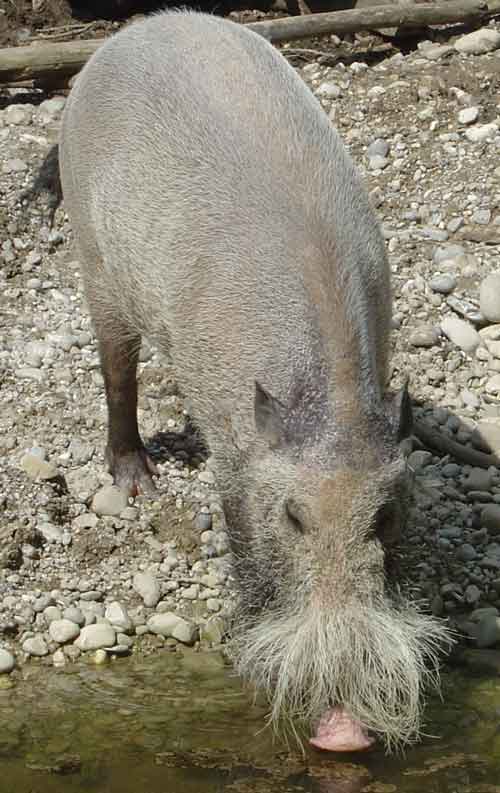
Sus barbatus (*)
Superregnum: Eukaryota
Cladus: Unikonta
Cladus: Opisthokonta
Cladus: Holozoa
Regnum: Animalia
Subregnum: Eumetazoa
Cladus: Bilateria
Cladus: Nephrozoa
Superphylum: Deuterostomia
Phylum: Chordata
Subphylum: Vertebrata
Infraphylum: Gnathostomata
Megaclassis: Osteichthyes
Cladus: Sarcopterygii
Cladus: Rhipidistia
Cladus: Tetrapodomorpha
Cladus: Eotetrapodiformes
Cladus: Elpistostegalia
Superclassis: Tetrapoda
Cladus: Reptiliomorpha
Cladus: Amniota
Cladus: Synapsida
Cladus: Eupelycosauria
Cladus: Sphenacodontia
Cladus: Sphenacodontoidea
Cladus: Therapsida
Cladus: Theriodontia
Subordo: Cynodontia
Infraordo: Eucynodontia
Cladus: Probainognathia
Cladus: Prozostrodontia
Cladus: Mammaliaformes
Classis: Mammalia
Subclassis: Trechnotheria
Infraclassis: Zatheria
Supercohors: Theria
Cohors: Eutheria
Infraclassis: Placentalia
Cladus: Boreoeutheria
Superordo: Laurasiatheria
Cladus: Euungulata
Ordo: Artiodactyla
Cladus: Artiofabula
Subordo: Suina
Familia: Suidae
Genus: Sus
Species: Sus barbatus
Subspecies: S. b. barbatus – S. b. oi
Name
Sus barbatus Müller, 1838
References
Sus barbatus in Mammal Species of the World.
Wilson, Don E. & Reeder, DeeAnn M. (Editors) 2005. Mammal Species of the World – A Taxonomic and Geographic Reference. Third edition. ISBN 0-8018-8221-4.
Sus barbatus – Taxon details on Integrated Taxonomic Information System (ITIS).
IUCN: Sus barbatus (Vulnerable)
Vernacular names
čeština: Prase vousaté, Bornejské prase, Vepř vousatý
Deutsch: Bartschwein
English: Bearded Pig
español: Jabalí o cerdo barbudo
suomi: Partasika
français: Sanglier à moustaches
עברית: חזיר מזוקן
magyar: Szakállas disznó
Bahasa Melayu: Babi Hutan
Nederlands: Baardzwijn
português: Porco barbado
Türkçe: Sakallı yaban domuzu
The Bornean bearded pig (Sus barbatus), also known ambiguously as the Sunda bearded pig or simply bearded pig, is a species in the pig genus, Sus.[2]
It can be recognized by its prominent beard. It also sometimes has tassels on its tail. It is found in Southeast Asia—Sumatra, Borneo, the Malay Peninsula, and various smaller islands like in Sulu archipelago such as Tawi-Tawi, where it inhabits rainforests and mangrove forests. The bearded pig lives in a family. It can reproduce from the age of 18 months, and can be cross-bred with other species in the family Suidae.
Subspecies
Skull
The two subspecies of this pig are:[2]
S. b. barbatus (the nominate subspecies)
S. b. oi (the western bearded pig)
As traditionally defined, the nominate is from Borneo. The species is widely ranging in Borneo. It is also found in Tawi-Tawi province at the tip of the Sulu Archipelago in the Philippines, although possibly has been extirpated,[1] and S. b. oi is from the Malay Peninsula and Sumatra. Genetic evidence suggests this is incorrect, and S. b. oi is better limited to Sumatra, leaving bearded pigs from both Borneo and the Malay Peninsula in the nominate subspecies.[3] Those from Bangka Island appear somewhat intermediate between the two subspecies.[3]
The Palawan bearded pig (Sus ahoenobarbus) has formerly been considered a subspecies of the bearded pig. However, as indicated by its genetic and morphological distinctness, under the phylogenetic species concept (which does not use subspecies) it needs to be elevated to full species status; while the situation is less clear under other species concepts (as not all S. barbatus populations have been restudied in modern times), the presently available information seems to favor full species status for S. ahoenobarbus in any case.[3]
In captivity
The San Diego Zoo was the first zoo in the Western Hemisphere to breed them.[4]
As of January 2016, it was held in the London Zoo, Berlin Zoo, Gladys Porter Zoo, National Zoo of Malaysia (Zoo Negara), Zoo Taiping, Night Safari, and Southwick's Zoo.[5] The animals at Hellabrunn Zoo were euthanized in 2017 because of old age,[6] and there is only one male left at the Berlin Zoo. Three individuals (one castrated male and two females) left at London Zoo[7] and one individual left at Gladys Porter Zoo[8] and the individuals were replaced by red river hogs in Southwick's Zoo as of 2017, which means that the species will likely disappear soon from European and American zoos.
References
Luskin, M.; Ke, A.; Meijaard, E.; Gumal, M. & Kawanishi, K. (2017). "Sus barbatus". IUCN Red List of Threatened Species. 2017: e.T41772A123793370. Retrieved 23 May 2021.
Grubb, P. (2005). Wilson, D. E.; Reeder, D. M. (eds.). Mammal Species of the World: A Taxonomic and Geographic Reference (3 ed.). Baltimore, MD: Johns Hopkins University Press. ISBN 0-8018-8221-4. OCLC 62265494.
Lucchini, Meijaard, Diong, Groves and Randi (2005). New phylogenetic perspectives among species of South-east Asian wild pig (Sus sp.) based on mtDNA sequences and morphometric data. J. Zool., Lond. 266: 25–35
"San Diego Zoo Website". Retrieved 27 February 2018.
ISIS (2011). Sus barbatus. Version 12 January 2011
"ZooChat". Retrieved 27 February 2018.
"Zootierliste Homepage". Retrieved 28 November 2016.
"ZooChat Gallery, Last Bornean Bearded Pig in AZA". Retrieved 27 February 2018.
Retrieved from "http://en.wikipedia.org/"
All text is available under the terms of the GNU Free Documentation License

